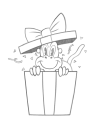This exercise will help you avoid chicken scratch. Instead of uncertain pecking at the paper. We're going to draw each line with a focused and intentional path. Remember to draw from your shoulder, elbow and wrist. Avoid the fingers. When I tell you guys to simplify your lines, I'm usually referring to three types of lines, two curves and one straight.
Join the premium course for additional and extended lessons, full lesson notes, assignment demonstrations, and more!
Download the photo reference images and try to simplify them using CSI lines. Draw each line with a focused and intentional path.
Your pace should be quick, but not rushed.
For this exercise, we will just consider the individual segments of the contour of a shape.
Same instructions for level one and two. Just a difference in difficulty of reference. The level two photos have more fun little tidbits to tempt you to get into the details, but fight the urge and simplify.
Also, no shading in these please. This is not meant to be a portfolio piece.
CSI
C = C Curves
S = S Curves
I = Straights
If you'd like to have a chance to be included in the upcoming critique videos, you must submit your drawings below by February 16th.
































